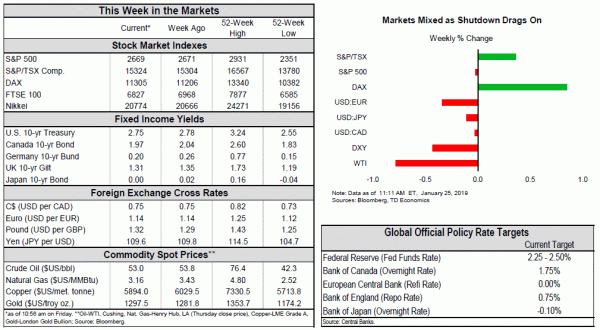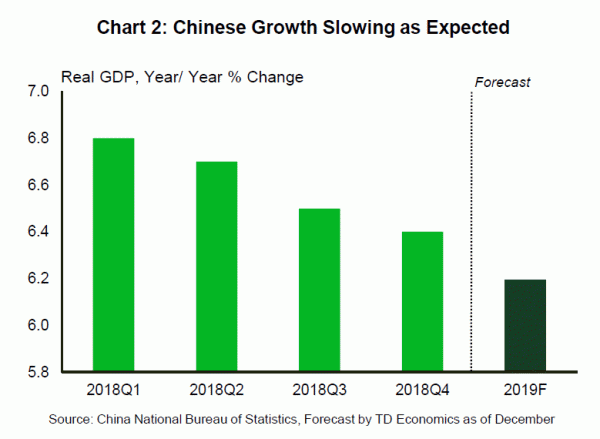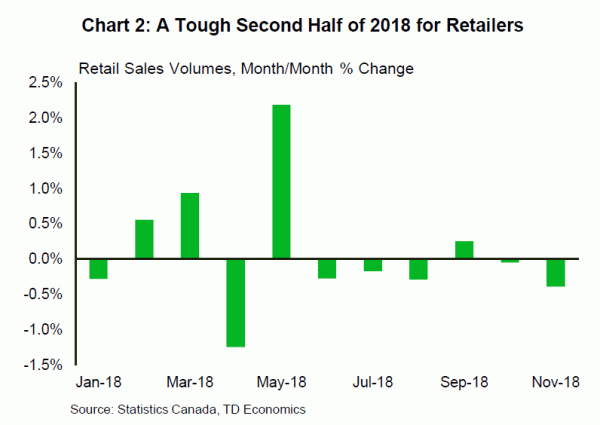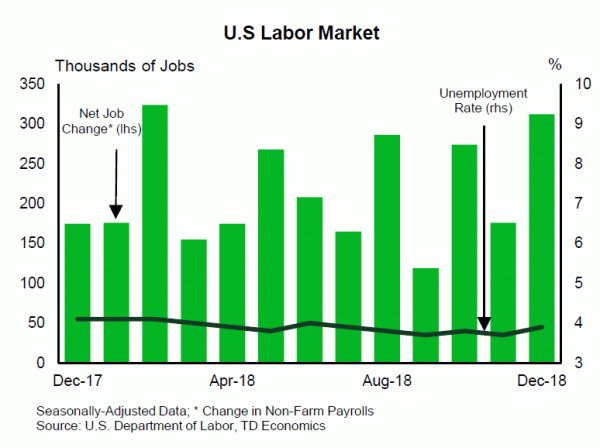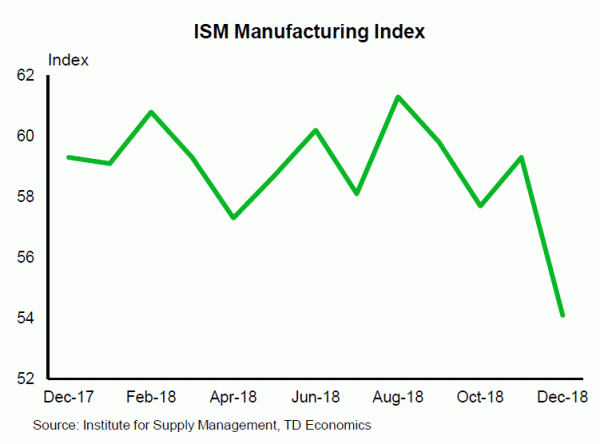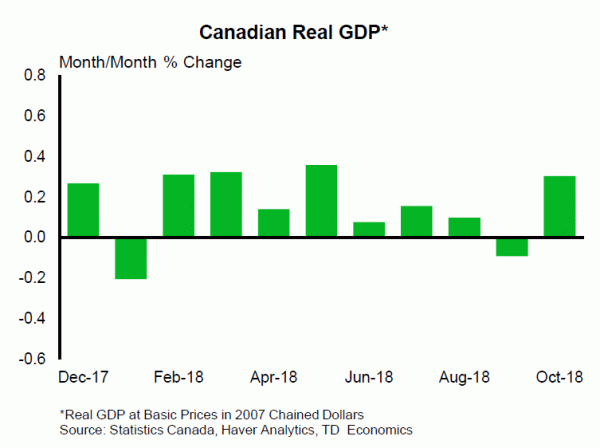The Weekly Bottom Line
U.S. Highlights
- Global equity markets are up on the week, despite some negative economic news, and continued dysfunction in Washington. The ECB characterized the economic risks as to the downside, and will be more cautious removing stimulus.
- Amidst the U.S. partial government shutdown there was little data to unpack. Home sales showed a sour end to 2018 for real estate. Negotiations in Congress continue, but there is no clear end to the impasse at time of writing.
- Next week we get some key events – an FOMC rate decision with a press conference, and a payrolls report. Furloughed federal workers are expected to lift the unemployment rate, but should not affect the payrolls tally.
Canadian Highlights
- The TSX and Canadian dollar traded sideways this week, hanging onto recent gains. Still, the WCS heavy oil price pushed higher and is up markedly compared to its November trough – a good news story for the beleaguered oil sector.
- Economic data released this week reinforced the slowing growth narrative, with wholesale activity, manufacturing sales and retail spending falling in November. The disappointing reports also caused us to shave our Q4 growth forecast. This softer economic backdrop should keep the Bank of Canada on hold at least until July.
U.S. – Markets Up Despite Lack of Good News on the Economy
Global equity markets are up on the week, despite some negative economic news, and continued dysfunction in Washington. Most notably, Mario Draghi said that the risks to growth have moved to the downside, and the ECB will be even more cautious withdrawing stimulus. This more cautious view was supported by recent data, which showed worsening sentiment in the manufacturing sector, and in its leading economy (Chart 1).
We also got confirmation that China’s economy slowed dramatically in the second half of 2018 (Chart2). The rebalancing of China’s economy towards domestic consumption is underway, but the downward pressure from weaker construction and infrastructure investment on headline growth is being exacerbated by unanticipated declines in consumer and business sentiment resulting from trade tensions with the U.S.. So far the data remains consistent with our December forecast that calls for Chinese economic growth to slow further to 6.2% in 2019.
With the U.S. partial government shutdown affecting some government statistical agencies, there was little economic data this week. We did see that the resale housing market ended 2018 on a weak note, but we don’t know what the housing starts or permit picture looked like.
Looking ahead to next week, the closely watched advance release of Q4 real GDP growth is likely to be delayed. The incomplete picture of the U.S. economy is coming at an inconvenient time. Economists are trying to determine if the weakness in financial markets in the fourth quarter, which has already contributed to dampened consumer and business sentiment in survey data, is also showing up in real measures of spending and activity.
The Federal Reserve will still meet next week amidst the shutdown. We will get to hear from Chair Powell at a post-meeting press conference, as the Fed moves to holding a press conference at every meeting. The Fed is widely expected to keep rates steady, consistent with recent speeches, which emphasized the ability to be patient to see how the economy fares in the wake of slower global growth and the deterioration in sentiment.
Fortunately, we are not in a total data vacuum. Next week, the BLS will release employment data, where we will see if the blistering hiring activity in December carried over into January. As legislation has been passed guaranteeing furloughed federal workers back pay to cover the shutdown, these workers will not dampen the payrolls tally. However, they are still likely to boost the unemployment rate. The reference week for the Household survey was January 6-12th, and furloughed federal employees (0.2% of the labor force) would be classified as unemployed. Assuming federal workers are appropriately sampled in the survey, this could result in a 0.2 percentage point boost to the January unemployment rate. Meanwhile, the economic hit from the shutdown continues to mount. Growth in the first quarter is looking soft at 1.4% (annualized), assuming a 0.2%-pt direct hit from the shutdown if it lasts to the end of January.
Canada – Data Confirms Slowing Growth Narrative
The TSX and Canadian dollar traded sideways this week, hanging on to recent gains. Still, the trend remains a friend, with both asset classes significantly off the lows seen late last month. Meanwhile, the price of WCS oil pushed higher during the week and is up over 200% compared to its November trough – a good news story for the beleaguered oil sector. On the data front, the news was less encouraging as economy watchers were delivered a trio of disappointing reports. Wholesale activity, manufacturing sales, and retail spending all declined in November, consistent with the softer economic backdrop expected by the Bank of Canada and prompting a modest downward revision to our fourth quarter growth forecast.
Manufacturing activity came in shy of expectations, with volumes dropping 0.9%. The petroleum and coal sector was the chief culprit (Chart 1), with maintenance and turnaround work contributing to an outsized decline in sales. The immediate outlook for this sector is no brighter, with Alberta’s oil production curtailment plan commencing on January 1st.
Stripping out the petroleum and coal sector, the picture was a little bit brighter, with manufacturing sales edging 0.2% higher. Peering ahead, manufacturing should find support from still-solid U.S. demand and a low-flying loonie, giving aid to the much needed rotation from consumer spending to investment and export-led growth. However, the aforementioned oil production cuts will exert a significant near-term drag on manufacturing output and overall GDP growth.
November was another weak month for retail spending (Chart 2). With households feeling the pinch of rising interest rates, retail volumes dropped 0.4% during the month, weighed down by falling motor vehicle and parts sales. Sales in this rate-sensitive sector are now tracking a modest year-to-date drop through November, a marked change from the 6% gain averaged the prior three years. The impact of rising borrowing costs is also being felt at retailers tied to housing markets. Volumes at building material and garden equipment supplies stores dropped for the fifth straight month in November. Sales of these items are now down 3.9% compared to a year ago, the worst performance since 2013. Not to be outdone, sales at furniture and home furnishing stores were also significantly lower year-on-year in November. Going forward, household spending will likely remain muted through 2019, as debt burdened households contend with rising borrowing costs.
Putting it all together, the dataflow suggests that overall economic activity likely pulled back in November, and for fourth quarter as a whole will come in softer than previously anticipated. We now expect growth closer to the 1% mark, not far off the Bank of Canada’s estimate of 1.3%. This softer economic backdrop combined with well contained inflation should keep a patient Bank of Canada in wait-and-see mode for some time yet.
U.S.: Upcoming Key Economic Releases
U.S. Employment – January
Release Date: February 1, 2019
Previous: 312k, unemployment rate: 3.9%
TD Forecast: 150k, unemployment rate: 4.0%
Consensus: 160k, unemployment rate: 3.9%
TD expects payrolls to mean-revert to 150k in January following the eye-popping jump to 312k in December. In effect, we expect some of last month’s unexpected gains in employment to be given back in January. In particular, we see scope for softness in the manufacturing sector after three consecutive months of solid payroll gains and as supported by the regional Fed surveys, which point to some weakness in the sector. In addition, employment in the retail sector may also revert back following a strong hiring streak during the holiday season (November-December). Weaker employment signal may also be exhibited in the household survey as a consequence of furloughed federal employees due to the ongoing government shutdown. Indeed, we anticipate the unemployment rate to reflect this by a tick up to 4.0% in January, and we see further risks to the upside. Lastly, we expect wages to keep their momentum and rise 0.3% m/m, maintaining the annual print unchanged at 3.2% in January.
U.S. ISM Manufacturing – January*
Release Date: February 1, 2019
Previous: 54.1
TD Forecast: 53.3
Consensus: 54.3
ISM-adjusted regional surveys suggest the manufacturing ISM likely fell further in January following the sharp 5.2 decline in December. In particular, both the adjusted Empire and the Philly Fed manufacturing surveys pointed to further softness at the start of the year. Although our forecast currently stands below consensus expectations, we note that at that level the ISM index would remain in expansionary territory that still suggests above-trend GDP growth. Based on the surveys, we expect the inventory and employment components to lead the decline, while new orders has the potential to stabilize following its large decline in December.
Canada: Upcoming Key Economic Releases
Canadian Real GDP – November
Release Date: January 31, 2019
Previous: 0.3%
TD Forecast: -0.1%
Consensus: N/A
The Canadian economy is projected to take a step backward in November with a 0.1% decline in industry-level GDP. Early signs are pointing towards a broad slowdown in activity as headwinds emerge across both goods and services. Energy will be an acute source of pain, reflecting voluntary shut-ins across the oil sands as producers grappled with blowout spreads on Canadian crude oil. Weaker construction and manufacturing activity will weigh further on output from the goods-producing sector while services will contend with a pullback in real retail and wholesale sales alongside ongoing softness in existing home sales. Given uncertainty around the impact of crude oil shutdowns we view risks as tilted to the downside, although the 0.3% increase from October will help blunt the impact on Q4 growth. The BoC has already set a relatively low bar at 1.3%, but a 0.1% decline would likely imply a growth tracking closer to the 1% mark.




